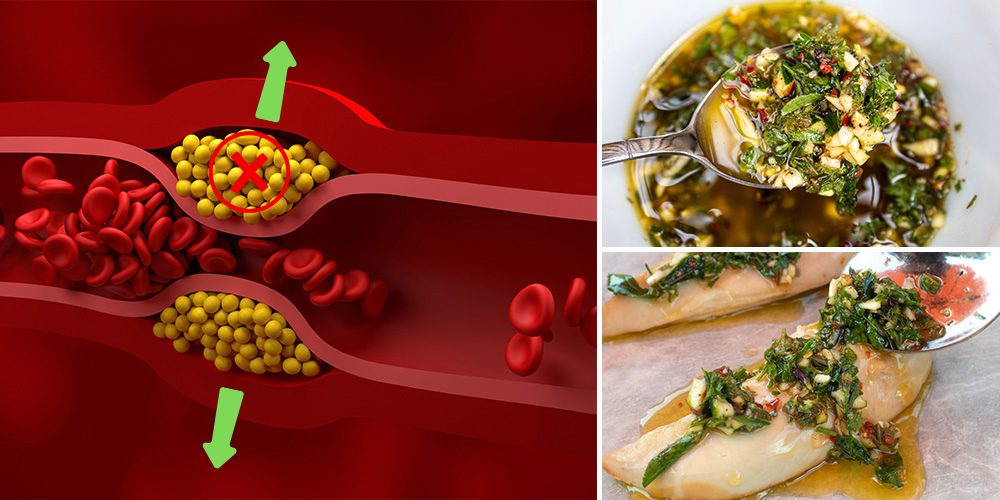
Do This If You Struggle With High Cholesterol
Dealing with high cholesterol can be a daunting, challenging experience. It’s something that is dealt with from diagnosis on. As daunting as it is, compelling evidence shows that people have successfully managed their cholesterol levels by changing lifestyle habits and eating natural foods. But what can high cholesterol do to you, and what can you do about it? Let’s start at the beginning — and if you’re already struggling with this, Do This If You Struggle With High Cholesterol might be the most important thing you read today.
What is cholesterol?
Cholesterol is a ceraceous fatty substance produced by the body’s organs and through the breakdown of food. After food and liquids are ingested, the stomach sends the broken-down contents to the intestines.
The intestines break these contents down even further into neat little protein-covered packages, containing triglyceride molecules of fats topped with its freshly produced cholesterol, called chylomicrons. These packages allow cholesterol to be transported in blood.
The liver produces the same little packages as the intestines, instead using carbs, proteins, and apolipoproteins along with cholesterol.
These packages are called very-low-density-lipoprotein or VLDL particles. Both, the liver and intestines, produce packages called high-density-lipoprotein or HDL which come with phospholipids.
The chylomicrons, very-low-density-lipoprotein particles, and high-density-lipoprotein particles then send their neatly packaged cholesterol around your body via the bloodstream, to other organs, nerve fibers, and tissues.
This packaged cholesterol helps your body build new cells, create vitamins, and produce hormones that give you the energy to walk the block.
Cholesterol comes in many different types, five to be exact, some types morphing into other types and all of them doing individual things for our bodies, both good and bad.
Types of Cholesterol
As cholesterol types chylomicrons, VLDLs, and HDLs flow around the body, your cells begin taking fatty acids from each little package for the cells to perform their daily tasks. As this happens they morph into a type known as intermediate-density-lipoprotein or IDL.
When the IDL packages have little to no fatty acids remaining they have finally morphed into low-density-lipoprotein or LDL.
Responsibility of Cholesterol Types
The initial forms of chylomicrons, VLDLs, and HDLs are responsible for transporting the lipoprotein packages to various locations throughout the body. HDLs are also responsible for clearing the bloodstream of any left-over packages.
Like its previous form, IDLs carry cholesterol and triglycerides from the liver to peripheral tissues. LDL is the final morphed package that attaches itself to the LDL receptors as it flows through the bloodstream, and there it waits.
Good Cholesterol
High-density-lipoprotein, HDL, is an essential tool for your body when it comes to protecting your heart’s health. As HDL flows through your bloodstream it picks up any build-up of cholesterol, preventing atherosclerosis and cardiovascular disease, as well as eliminating blockages that could cause heart attacks and strokes.
After picking up the scraps of cholesterol, HDL transports itself back to the liver to be eliminated.
Bad Cholesterol
Low-density-lipoprotein, LDL is what makes having high levels of cholesterol dangerous. LDL binds to LDL receptors in the blood vessel walls as it travels the bloodstream and high cholesterol could cause a buildup.
When buildups are broken from the walls, they flow through your arteries and become lodged, clogging arteries in your heart or brain. This causes chest pain, cardiovascular disease, hemorrhagic or ischaemic stroke, and heart attacks.
High levels of IDL and LDL have also been linked to cancer, chronic respiratory disease, and peripheral artery disease.
But the chance of all these can be easily lowered by helping your body fight against its weaknesses. Herbal remedies that target your heart are essential to anyone’s medicinal cabinet. Here’s the already-made remedy that made me avoid cholesterol buildup.
What Causes High Cholesterol?
Our bodies produce four times the amount of cholesterol than we ingest. Naturally, this causes an influx of cholesterol levels and our body should manage those levels accordingly. However, discrepancies within the body can permanently cause cholesterol levels to go haywire, including health conditions such as:
- Allergies
- Diabetes
- HIV/AIDS
- Hypothyroidism
- Kidney disease
- Lupus
Even if these health conditions are daunting, some are still manageable. Take MS for example. Fatigue, excruciating pain, difficulty walking, Balance issues, and numbness… are only a few of the symptoms of this condition. Yet people are thriving with nothing but natural remedies. Here’s how Nicole Apelian thrives even with MS. She’s a living example of nature’s medicine being the best.
If you eat foods that have been dipped in sugar, full-fat dairy, meat that has been processed, or fried foods, your cholesterol levels will rise. These types of food, and the consequences, usually go hand-in-hand with poor lifestyle choices such as binge-watching TV series, spending the weekends in bed, and choosing to drive rather than walk.
How To Manage Cholesterol Naturally
Now that we have a better understanding of what high cholesterol is and what it does, we can make sense of what is needed to keep the levels in check. Everyone’s personality is different, but we all need fun in our lives so here are a few weird things you can do to help lower your cholesterol:
- Laugh – We all know how we feel after a good laugh; somewhat exhausted but feeling great! Well, it has been proven that laughter directly lowers your cholesterol. So, laugh hysterically!
Did you some people haven’t had a good laugh in months? Maybe years? It shouldn’t happen to anyone. If stress drags your mood down… you should know it’s as unhealthy as fast food. Check out the ingredients of this tincture that relieves you form Stress and Anxiety.
- Dance – Turn on your favorite toons and flail those arms and legs, in public or a private room that’s up to you. If your skills don’t include dancing try classes or Zumba!
It sound childish, but trust me, once you move a little, you immediately feel better. I didn’t do it for a long time because my joints weren’t ready for it. I knew they would start hurting. But that was only until I started to use cayenne pepper to warm them up and numb the pain. Using only cayenne on your skin can be damaging, so I don’t recommend you do so.
Rather, check out this soothing salve that takes away your joint pain in minutes. I use it every morning, and the whole day feels like walking in my 20s!
- Sit – If dancing or laughing isn’t your thing, try this: find a welcoming forest with a bench to sit on. Sit quietly on that bench for at least 20 minutes and focus on your surroundings. Play this game: 5 colors, 4 shapes, 3 textures, 2 human-made objects, and 1 animal. This is a perfect game to distract your mind and keep you sitting in nature longer than you let yourself.
Eating whole foods will help manage high cholesterol, along with fruits, greens, fish, and nuts. If it grows in your garden or walks on your farm, it will likely help you manage cholesterol levels.
Alfalfa, Medicago sativa, has saponins that help lower cholesterol. Surprisingly, the entire alfalfa plant is edible. You can use it by eating the flowers, young leaves, and sprouted seeds; they go well in salads. The root can be dried, peeled, and crushed at one end to make a toothbrush!
Yarrow, Achillea millefolium, has edible flowers and leaves that help lower cholesterol. The young leaves and flowers can be used in a broth, dried as spices, or eaten raw. The taste of yarrow is similar to tarragon, it’s sweet and mild and works well in almost any recipe, like this one!
If you don’t want to get your hands dirty and make DIY remedies, here’s the Yarrow Tincture I’ve been using, and proved useful for years.
How to Make Sweet Green Chole-Churri (ChimiChurri for high cholesterol)
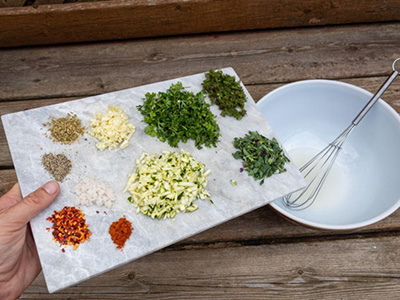 Ingredients
Ingredients
- ½ cup of Extra Virgin Olive Oil
- 2 tablespoons of White Wine Vinegar
- ½ cup of finely chopped fresh Parsley leaves
- ¼ cup of finely chopped young Yarrow leaves and flowers
- ¼ cup of finely chopped young Alfalfa stems, leaves and flowers (sprouted seeds can also be included)
- ½ cup of finely chopped Zucchini
- 3 large Garlic Cloves finely chopped
- 1 teaspoon of Sea Salt
- ¾ teaspoon of dried Oregano
- ½ teaspoon of Black Pepper
- ½ teaspoon of Red Pepper Flakes
- ¼ teaspoon of Paprika
Instructions
- Set aside the olive oil for step 2 and thoroughly whisk the rest of the ingredients in a large bowl.

- Add the ingredients to a serving bowl and pour the olive oil over top.

- Let sit and marinate for 2 hours before enjoying it on everything and storing it for later!









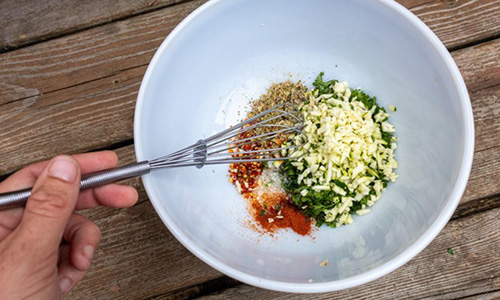
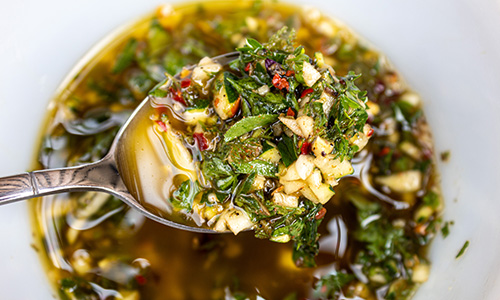
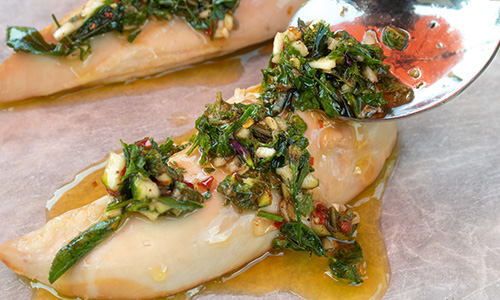
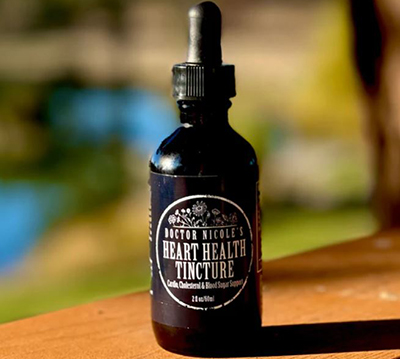
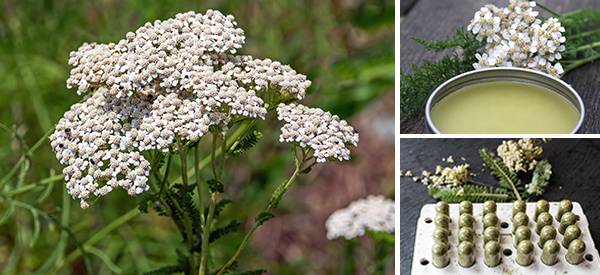
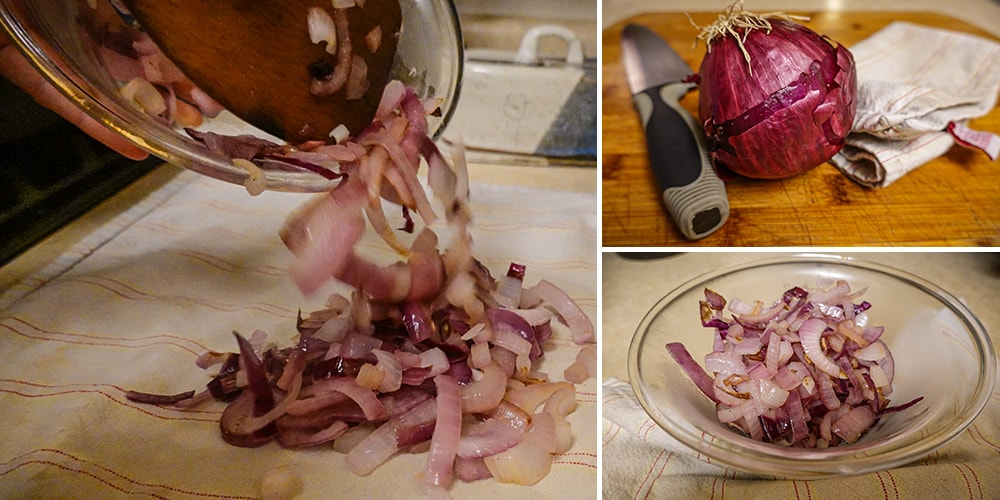

In the last picture… is the mixture put on bread?
Looks like chicken to me.
What activities do you suggest for someone with CMT who has very little balance or strength do to myelin destruction and muscle atrophy.
Chair Yoga
My son has CMT also. He grew up at Scottish Rites Hospital. He is now 43 and just had his 6th surgery. 3 months in a wheel chair. I would love to find out what nature has to offer for nerve pain
hello there
i do chair yoga every day
on utube it’s called gentle chair yoga
2 women with pink tshirts
check it out
It has been very helpful for my balance, strength, pain and flexibility
peace and love
Where do I buy Yarrow leaves and flowers?
Can you take yarrow tincture or yarrow capsules? Will it have the same effect?